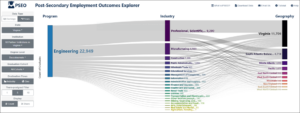New Post-Secondary Employment Outcomes Data Available from Census Bureau
This blog post was provided courtesy of Andrew Foote, Principal Economist with the Longitudinal Employer-Household Dynamics (LEHD) program, part of the Center for Economic Studies at the U.S. Census Bureau.
On January 11, the U.S. Census Bureau’s Post-Secondary Employment Outcomes (PSEO) project released new data on earnings from institutions of higher education. These data report earnings outcomes at the institution level for degree levels and fields of study, as well as employment by geography and industry sector, and are made possible by a partnership between the Census Bureau and state higher education boards. For a complete list of partners, refer to the PSEO website here. PSEO is an experimental data product based on partnerships between university systems, state higher education systems, and the Census Bureau, the Post-Secondary Employment Outcomes (PSEO) are tabulations providing national earnings and employment statistics for graduates of post-secondary institutions.
These data are particularly useful for students, employers, and policymakers to make informed decisions about education and employment. This article provides a few facts about the data, with links to the corresponding PSEO Explorer visualizations.
The PSEO data for Minnesota and Wisconsin show that graduates from the flagship institutions (University of Minnesota – Twin Cities and University of Wisconsin – Madison) have very different geographic mobility one year after graduation. 80 percent of graduates from UMN-TC stay in Minnesota one year after graduation, compared with 55 percent of graduates from UW-Madison staying in Wisconsin. Despite the differences in geographic mobility of the graduates, both sets of graduates end up in similar industry sectors, with professional services, education, and health care being the top three destinations for both schools.
The data also can help students understand what their likely earnings trajectories are for their early career after graduating. Business administration majors from University of South Carolina can earn a median of under $40,000 one year after graduation, while Registered Nursing graduates earn a median of $56,000 one year after graduating (link here). The PSEO data also report the quantiles of earnings, which shows that the 25th percentile of earnings for registered nursing graduates is almost equivalent to the 75th percentile of earnings for business administration graduates at University of South Carolina.
If you want to explore a specific major or institution, the best place to start is by going to the PSEO Explorer page here.
A screenshot from the PSEO Explorer Tool
Why Is This Data Important?
The PSEO data can be used by students to make informed decisions about where to attend college and which majors to choose. If a student is interested in working in a particular industry, they can use the data to see which colleges have strong programs in that field.
The data can also be used by policymakers to make decisions about education and workforce development. For example, if a state is seeing a decline in manufacturing jobs, they can use the data to see which colleges are producing graduates in that field.
Finally, the data can be used by employers to make decisions about hiring and training. If an employer is looking for employees with a particular skill set, they can use the data to see which colleges are producing graduates with those skills.
How Can I Get the Data?
The PSEO data is available on the Census Bureau’s website. The PSEO Explorer allows users to quickly interact with the data, and the data can also be downloaded from the Census website.
For more information about the PSEO project, please visit the Census Bureau’s website.
